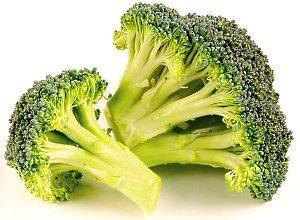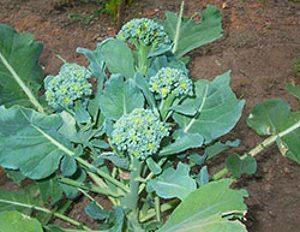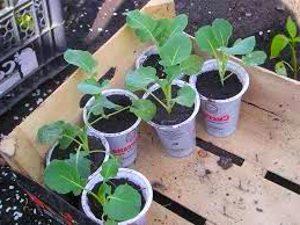Features of growing broccoli cabbage
 The annual broccoli crop belongs to the cabbage family and is a subspecies of cauliflower. Despite the fact that this vegetable appeared on domestic beds relatively recently and is considered very exotic, it is unpretentious and quite suitable for growing in local climatic conditions.
The annual broccoli crop belongs to the cabbage family and is a subspecies of cauliflower. Despite the fact that this vegetable appeared on domestic beds relatively recently and is considered very exotic, it is unpretentious and quite suitable for growing in local climatic conditions.
Varieties of broccoli cabbage
Broccoli is similar in appearance to cauliflower. It has a dense head, consisting of inflorescences, which is used for food.
There are two main types of broccoli:
- usual;
- asparagus.

Asparagus broccoli produces several slender stems with small heads.
In total, there are more than a hundred varieties in the world, a couple of dozen are cultivated in Russia.
Requirements for temperature, humidity and soil
Broccoli cabbage is demanding on light and moisture. Recommended soil moisture - 75%, air - 85%. The vegetable is not very sensitive to high and low temperatures: it tolerates frosts down to -7 ºC, does not need shading of the head. The optimum temperature range is 16-25 ºC.
The culture prefers loose, slightly alkaline and neutral soils. It is recommended to grow it in areas where potatoes, carrots, and legumes were found last year. Bad predecessors are radishes, turnips, radishes, cabbage, tomatoes. It is not recommended to plant broccoli in the same areas earlier than after 4 years.
Growing seedlings and planting broccoli cabbage in open ground
Seeds selected for planting are disinfected in a manganese solution for half an hour. They are then rinsed in cold water. Such a procedure will help in the future to cope with most typical diseases. To enhance resistance to pests and increase yields, seeds are treated with Agat-25, Albit, El-1 or similar preparations.
 The seedling method of growing broccoli is considered more efficient. The vegetable belongs to late crops, and the timing of its planting is also late. In this regard, there is no need to grow seedlings in heated rooms. The term for planting seeds is late April - early May. If by this time warm weather has not been established, then it is enough to cover them with a film. Picking broccoli cabbage is done after 2 weeks. After another week, the seedlings begin to harden, gradually opening access to air, wind and sun.
The seedling method of growing broccoli is considered more efficient. The vegetable belongs to late crops, and the timing of its planting is also late. In this regard, there is no need to grow seedlings in heated rooms. The term for planting seeds is late April - early May. If by this time warm weather has not been established, then it is enough to cover them with a film. Picking broccoli cabbage is done after 2 weeks. After another week, the seedlings begin to harden, gradually opening access to air, wind and sun.
Planting broccoli cabbage in open ground is done after 30-45 days, when the sixth true leaf is formed on the plants. It is better to prepare the beds in advance. In autumn liming is carried out and fertilizers are applied: manure, superphosphate, potassium nitrate. Crushed eggshells work well for liming. Garden beds can be fertilized just before planting. Top dressing perfectly cope with the problem of lack of nutrients in the soil.
It is better to plant broccoli cabbage outdoors in cloudy weather or in the evening when solar activity is declining. Planting scheme 40x60 cm.
The pits are pulled out quite deep: most of the stem when planting should remain below the level of the bed. As fertilizers add ash, compost and dolomite flour. The plants are deepened by about 1 cm.As they grow, soil is poured into the holes until they are completely aligned with the level of the garden.
Caring for broccoli cabbage
 Caring for broccoli cabbage includes weeding, watering, feeding, pest control. It is recommended to water this moisture-loving culture once every 2 days, and in hot weather, increase the frequency of watering up to 2 times a day. A moist soil layer with a depth of about 15 cm should be constantly maintained. Watering preferably in the evening hours. After each watering, the soil is loosened to avoid root rot.
Caring for broccoli cabbage includes weeding, watering, feeding, pest control. It is recommended to water this moisture-loving culture once every 2 days, and in hot weather, increase the frequency of watering up to 2 times a day. A moist soil layer with a depth of about 15 cm should be constantly maintained. Watering preferably in the evening hours. After each watering, the soil is loosened to avoid root rot.
Broccoli cabbage responds positively to feeding. They are recommended to be carried out even if the soil is well fertilized. The first feeding from cow dung (1:10) or bird droppings (1:20) is applied after the plants have rooted in the garden bed. The second is made after 2 weeks. The third is performed with the beginning of the formation of inflorescences. For her, you can use the following composition (based on 10 plants):
- water - 10 l;
- superphosphate - 40 g;
- ammonium nitrate - 20 g;
- potassium sulfate - 10 g.
After cutting off the central head, lateral stems with inflorescences begin to form on the plant, which will be a significant addition to the harvest. The following solution is used to stimulate their growth:
- water - 10 l;
- potassium sulfate - 30 g;
- superphosphate - 20 g;
- ammonium nitrate - 10 g.
Wood ash and nettle tincture will be a good addition to top dressing.
The main pest of the culture is the cruciferous flea. It may appear immediately after planting broccoli in the open field. You can protect young plants by covering them with a thin non-woven cloth. During the growth of broccoli cabbage, the drug "Iskra" is used to combat the pest, but it can be used only before the formation of inflorescences. Further measures are reduced to sprinkling the plants with a mixture of wood ash and tobacco dust or spraying with infusion of these components.
Harvesting and storage
 When growing broccoli cabbage, you need to ensure that it does not overripe, and cut the head off until yellow flowers appear. Otherwise, the vegetable becomes unfit for human consumption. The central shoot is cut off when it reaches a length of 10 cm. The inflorescences are removed together with the stem. Like cauliflower, the top is juicy and tasty. It is better to harvest in the morning to prevent the plants from withering in the sun. Early varieties harvested in summer are unsuitable for long-term storage. The only way to preserve them is to freeze them. But the crop harvested in mid-autumn can be stored in a refrigerator or cellar at zero temperature for about 3 months.
When growing broccoli cabbage, you need to ensure that it does not overripe, and cut the head off until yellow flowers appear. Otherwise, the vegetable becomes unfit for human consumption. The central shoot is cut off when it reaches a length of 10 cm. The inflorescences are removed together with the stem. Like cauliflower, the top is juicy and tasty. It is better to harvest in the morning to prevent the plants from withering in the sun. Early varieties harvested in summer are unsuitable for long-term storage. The only way to preserve them is to freeze them. But the crop harvested in mid-autumn can be stored in a refrigerator or cellar at zero temperature for about 3 months.
After cutting the head, do not rush to remove the plant from the garden. Several lateral inflorescences with small heads will still form on it. Their development will take about a month. If the crop was harvested in the summer, then the addition to it is guaranteed. But the formation of lateral shoots in the fall is quite possible, thanks to the ability of broccoli to tolerate slight frosts. Plants sprout even if they are uprooted from the ground and just lie in the beds.